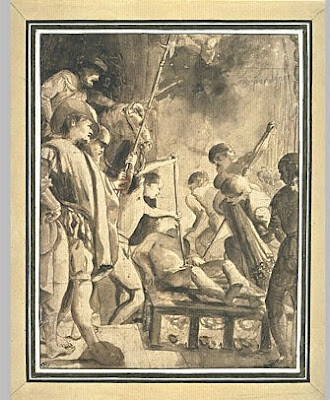 |
| Pietro Faccini Mary Magdalen at the Tomb of Christ before 1602 oil on canvas Musée des Beaux-Arts de Caen |
 |
| Pietro Faccini Martyrdom of St Lawrence ca. 1590 drawing Musée du Louvre |
 |
| Pietro Faccini Martyrdom of St Lawrence (detail) 1590 oil on canvas Chiesa di San Giovanni in Monte, Bologna |
 |
| Pietro Faccini Martyrdom of St Lawrence (detail) 1590 oil on canvas Chiesa di San Giovanni in Monte, Bologna |
 |
| Pietro Faccini The Annunciation before 1602 oil on copper Museo Civico di Modena |
 |
| Pietro Faccini The Annunciation ca. 1600 oil on canvas Pinacoteca Nazionale di Bologna |
 |
| Pietro Faccini The Annunciation (detail) ca. 1600 oil on canvas Pinacoteca Nazionale di Bologna |
 |
| Pietro Faccini The Annunciation (detail) ca. 1600 oil on canvas Pinacoteca Nazionale di Bologna |
 |
| Pietro Faccini Mystic Marriage of St Catherine, attended by St Jerome ca. 1595 oil on canvas Pinacoteca Capitolina, Rome |
 |
| Pietro Faccini Penitent St Jerome in the Wilderness ca. 1600 oil on copper Schorr Collection, London |
 |
| Pietro Faccini Figure Study of a Boy ca. 1590 drawing private collection |
 |
| Pietro Faccini Half-Length Figure Study ca. 1590 drawing Art Institute of Chicago |
 |
| Pietro Faccini Académie ca. 1585 drawing private collection |
 |
| Pietro Faccini Académie ca. 1585 drawing Cabinet des Estampes et des Dessins de Strasbourg |
 |
| Pietro Faccini Académie before 1602 drawing Musée du Louvre |
"Pietro Faccini's brief career seems to have begun at a relatively late age, when around 1583 he entered the Carracci academy in Bologna. His precocious talent is said to have aroused the jealousy of Annibale Carracci, however, and in the 1590s Faccini left the Carracci academy, later setting up his own school. . . . He may have traveled to Venice, and the influence of Tintoretto noted by his biographer Cesare Malvasia is evident in some of his later works. According to Malvasia, Faccini was a productive painter known for his small-scale decorative pictures, although only a handful of paintings by him survive today. . . . Aptly described by one scholar as 'one of the most creative and original draughtsmen of the Emilian school', Faccini drew in a variety of techniques, using pen and ink wash, red and black chalk, watercolour and oiled charcoal. His drawings were greatly admired for what Malvasia calls their gran spirito. They were especially popular with collectors, and Cardinal Leopoldo de' Medici is said to have owned over a hundred by the artist. Guercino also admired Faccini's drawings, which were a strong influence on his early chalk style, and is known to have possessed a number of nudi d'accademia by the artist. In fact, Malvasia reserves special praise for Faccini's drawings of the male nude, which he notes were often confused with those of Annibale Carracci: 'so many drawing from the nude, that one sees an infinity of his models in all the most famous collections, so sensational, so daring, fluttering, and what is more, so easy and frank, that look as if they were by his master [i.e. Annibale Carracci], many are sold every day as if the work of his hand.'"
– from biographical text published by Stephen Ongpin Fine Art, London